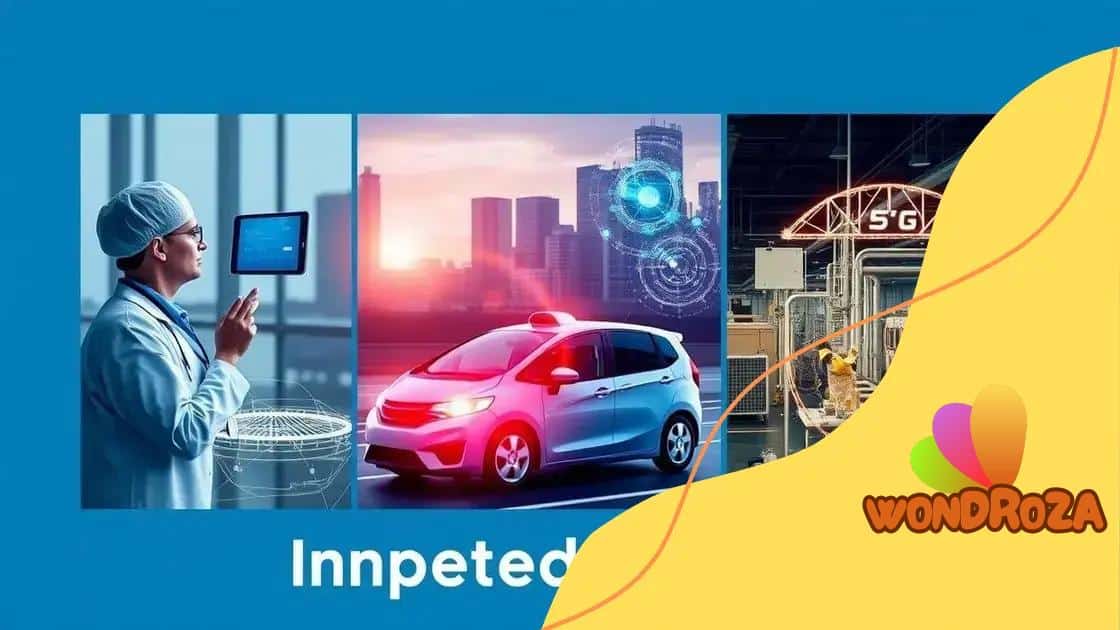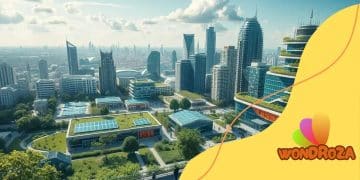The future of 5G technology and its global implications

The future of 5G technology significantly enhances global communication by offering faster speeds, lower latency, and greater connectivity, while shaping smart cities and transforming industries like healthcare and transportation.
The future of 5G technology is here, and it promises to revolutionize how we connect with the world. Have you ever wondered how faster speeds and lower latency will impact your daily life? Let’s explore what this means for everyone.
Understanding the basics of 5G technology
Understanding the basics of 5G technology is essential to grasp how it will transform our lives. This new generation of mobile networks promises faster speeds, improved reliability, and greater flexibility in communication.
What is 5G?
5G is the fifth generation of wireless technology, following 4G. It uses advanced technology to deliver faster data rates and lower latency, which means your devices can communicate more quickly and efficiently.
Key Features of 5G
- Higher Speeds: Expect speeds up to 100 times faster than 4G.
- Lower Latency: Reduced delay improves the experience of applications like gaming and video calls.
- Enhanced Capacity: More devices can connect at once without slowdowns.
This technology not only supports smartphones but also connects smart appliances, vehicles, and even cities. The result is an expanded internet of things (IoT), where everything communicates seamlessly.
Moreover, 5G will impact industries significantly. For example, healthcare will benefit from real-time data sharing for patient monitoring, while transportation could see advancements in autonomous driving.
In addition to practical applications, there are challenges to address with 5G. Infrastructure needs to be updated, and there are concerns about radio frequency exposure. Nevertheless, many countries are investing heavily in enhancing their 5G networks.
With its many possibilities, 5G technology is set to create a connected world like never before. Embracing this change now prepares us for exciting advancements in the future.
Key advantages of 5G over previous networks
Understanding the key advantages of 5G over previous networks is crucial as we enter a new era of connectivity. 5G boasts several enhancements that make it superior to its predecessors, particularly in speed, capacity, and responsiveness.
Faster Speeds
5G networks can deliver data speeds that are much faster than 4G. Users can expect download speeds that reach up to 10 Gbps. This means streaming high-definition content or downloading large files will be quicker than ever.
Lower Latency
One of the standout features of 5G is its low latency. With a response time of less than 1 millisecond, 5G technology will enable seamless communication between devices. This is particularly important for applications requiring real-time feedback, such as gaming and augmented reality.
- Enhanced User Experience: Fast response times lead to better performance in mobile applications.
- Support for IoT: More devices can connect efficiently, catering to the growing demand for smart technology.
- New Use Cases: Industries like healthcare and transportation can develop innovations based on real-time data.
Moreover, 5G networks have a greater capacity to handle more connected devices simultaneously. As cities become smarter and more devices join the network, this becomes increasingly vital.
Additionally, the capacity allows for the development of new technologies, such as autonomous vehicles and advanced robotics. These innovations can thrive in an environment where connectivity is robust and reliable.
These advancements represent a significant step forward in mobile network technology, setting the stage for a future where everything is connected faster and more effectively.
Global impact of 5G on industries

The global impact of 5G on industries is expected to be vast and transformative. As more sectors adopt this technology, we will witness significant changes in how businesses operate and communicate.
Healthcare Innovations
In the healthcare sector, 5G technology enables real-time patient monitoring and telemedicine. Doctors can access patient data instantly, leading to timely interventions and improved outcomes. For example, remote surgeries may soon become a reality, where specialists operate on patients from miles away using robotic tools connected via 5G.
Enhanced Transportation
The impact on transportation is also profound. With 5G, autonomous vehicles can communicate with each other and road infrastructure, reducing the likelihood of accidents. This enhanced connectivity leads to more efficient traffic management and improved public transit systems.
- Smart Traffic Signals: Can adapt in real-time based on conditions.
- Fleet Management: Companies can track their vehicles and optimize routes.
- Environmental Benefits: Reduced emissions as traffic flow improves.
Moreover, industries like manufacturing are set to benefit from enhanced automation and robotics. Machines equipped with 5G connectivity can exchange data at incredible speeds, improving productivity and quality control.
In the retail space, businesses can implement personalized shopping experiences, leveraging the data speed of 5G to offer tailored recommendations and augmented reality features. These innovations can significantly enhance customer engagement and satisfaction.
As industries adapt to adopt 5G technology, the economic growth prospects are bright. Companies that embrace this technology can gain a competitive edge, leading to job creation and increased economic activity.
Challenges in the rollout of 5G
The challenges in the rollout of 5G are significant and must be addressed for the technology to reach its full potential. As we transition from 4G to 5G, various obstacles stand in the way of successful implementation.
Infrastructure Needs
One major issue is the need for substantial infrastructure upgrades. 5G technology requires a denser network of small cell towers compared to previous generations. This means cities must invest in new installations and upgrades to existing sites to support the increased demand.
Regulatory Hurdles
Moreover, regulatory challenges can slow down the pace of deployment. Different regions may impose varying regulations or lengthy approval processes for new tower installations. These can delay the rollout, causing frustration among service providers and consumers alike.
- Permitting Issues: The process can take months or even years.
- Local Opposition: Communities may resist new towers in their neighborhoods.
- Variable Standards: Lack of uniformity in regulations across states or countries.
Another challenge is the substantial investment required. Deploying 5G technology is costly, and not all companies are able to bear these expenses. Smaller providers may struggle to keep up with larger competitors who can more easily fund the infrastructure needed.
Moreover, there are concerns over health risks associated with 5G. Public belief and skepticism regarding the safety of radiation emitted from cellular towers can influence rollout efforts. Education and transparency are essential to address these fears and ensure community support.
Lastly, the complexity of integrating 5G with existing networks poses a technical challenge. Businesses must ensure compatibility with their systems to avoid disruptions. Successful transition requires careful planning and management of both technology and resources.
The role of 5G in shaping smart cities
The role of 5G in shaping smart cities is transformative and pivotal in modern urban planning. With faster connectivity and improved network capabilities, 5G technology enables cities to function more efficiently and sustainably.
Enhanced Connectivity
5G technology offers enhanced connectivity that allows various devices and systems within the city to communicate seamlessly. This connectivity supports smart traffic management systems that can monitor traffic in real-time, reducing congestion and improving travel times.
Smart Utilities
Moreover, cities can utilize 5G for smart utility systems. For example, smart meters can track energy and water usage accurately, helping to conserve resources and reduce costs. This technology also allows utilities to respond quickly to outages or leaks.
- Energy Efficiency: Residents save on bills with optimized power usage.
- Water Management: Sensors detect leaks or inefficiencies.
- Waste Management: Smart bins signal when they’re full for efficient collection.
Additionally, 5G supports public safety initiatives. Smart surveillance cameras can enhance security by analyzing data in real time, helping law enforcement respond more effectively to incidents. Emergency services can share information instantly, allowing for quicker responses during critical situations.
As cities incorporate 5G technology, transportation systems can evolve. For instance, connected vehicles communicate with each other and infrastructure. This promotes safer driving conditions and enables the development of autonomous vehicles.
The integration of 5G in smart cities also fosters economic growth. Businesses can leverage data analytics to improve operations and customer experiences. Furthermore, innovation in tech startups can thrive in a well-connected environment, creating job opportunities and boosting the local economy.
FAQ – Frequently Asked Questions about 5G Technology and Its Impact
What are the main benefits of 5G technology?
5G technology offers faster speeds, lower latency, and greater capacity, significantly improving communication and connectivity for various applications.
How will 5G impact healthcare?
In healthcare, 5G will enable real-time patient monitoring and telemedicine, enhancing the efficiency and effectiveness of medical care.
What challenges are associated with the rollout of 5G?
Challenges include the need for significant infrastructure upgrades, regulatory hurdles, and public concerns about health impacts related to exposure to radio frequencies.
How does 5G shape smart cities?
5G technology enhances smart cities by enabling better traffic management, supporting smart utilities, and improving public safety through real-time data communication.





